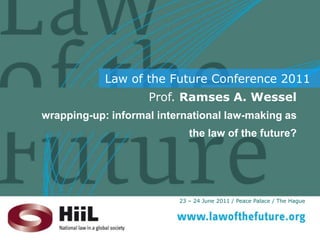
LOTF2011 | Ramses A. Wessel
- 1. Prof. Ramses A. Wessel wrapping-up: informalinternationallaw-making as the law of the future?
- 2. HiiL’s Law of the future Globalisation affects societies and, with that, the way in which legal systems function and interact Predictability and certainty as a function of law Towards a global legal environment: the mechanisms underlying authoritative rule-making, rule-enforcement, and dispute resolution beyond national borders Two major shifts in the global legal environment •From a predominantly national to a predominantly international legal environment • From a predominantly public legal regime to a mixed public-private regime or even predominantly private regime
- 3. HiiL’sThree Scenarios Global Constitution | An expansion of international rules and institutions, of a predominantly public nature. New Legal Borders | If the process of expansion of international rules and institutions reverses, we may expect a thickening of legal borders, dominated by state-made law (at national or regional level). Legal Internet | International rules and institutions can also further expand as part of a process of shifting emphasis from law created and enforced by state-connected institutions to private governance mechanisms and private legal regimes. If they do, the global legal environment will be characterised by a growing body of international rules and institutions with an increasingly public-private or even private nature.
- 4. IN-LAW: anadditional scenario? Towhatextent do the findings in the IN-LAW project fit the LOTF scenarios? IN-LAW is about: the “organization of global rulemaking” the emergence of regulatory networks and ‘international agencies’ regulation beyond the state the impact of new normative processes on States and even on individuals and businesses A reassessment of international law lawyers “continue to pour an increasingly rich normative output into old bottles labeled ‘treaty’, ‘custom’, or ‘general principles’” (Alvarez)
- 5. Informalinternationallaw-making (IN-LAW) Informal? The informality is related to (and/or) output, process or actors involved International? Transnational, ‘beyond the state’ Law-Making? the presumption is that the international cooperation, albeit less formal, falls within the remit of international law The question is whether it concerns an exercise of international public authority(Von Bogdandy et al)
- 6. Reasons for Informal International Law-MakingIN-LAW perceived as ‘second best’ Formal law-making is ‘too burdensome’ Formal law-making is ‘un-attainable’ Formal law-making is ‘technically impossible’ IN-LAW to favour the powerful IN-LAW to counter formal law-making
- 7. Reasons for Informal International Law-MakingIN-LAW Perceived as ‘First-Best’ IN-LAW as ‘cheaper’ alternative to achieve the same goal Formal law-making as ‘outdated’ IN-LAW as a ‘cultural practice’ (the Asian Way) IN-LAW as a ‘technical necessity’
- 8. Public? Private? The exercise of public authority The ‘exercise of international public authority’ “any kind of governance activity by international institutions, be it administrative or intergovernmental, should be considered as an exercise of international public authority if it determines individuals, private associations, enterprises, states, or other public institutions”. ‘Authority’ “the legal capacity to determine others and to reduce their freedom, i.e. to unilaterally shape their legal or factual situation”
- 9. Assessment Do lawyers need to rethink certain traditional aspects of international law (sources, actors)? In many cases international public authority is exercised through ‘unconventional’ international cooperation Questions related to legitimacy and accountability; for lawyers ‘constitutional questions’ (cf. GAL and international constitutionalism, pluralism) It is clear that there is no way back and that ‘global governance’ developed, either in the shadow of existing arrangements, or simply ‘bottom up’ through cooperation between national regulators.
- 10. Does IN-LAW fit the LOTF scenario’s? Starting points in scenario 1 (global constitution): A continued growth of international law and international legal institutions. The rules and institutions have a predominantly public nature. IN-LAW fit: yes, but the focus should be more on informal institutions than on formal organizations. Not so much a development towards a ‘global EU’; rather a more fragmented set of different regulatory regimes
- 11. Starting points in scenario 2 (new legal borders): The process of the expansion of international rules and institutions reverses and legal borders thickens. Those borders will almost by definition be dominated by state-made law. Regional organisations emerge as a key part of developing legal borders to insulate against the global legal environment that has developed to date. IN-LAW fit:no. IN-LAW points to an increase of international rules and institutions, albeit that the actors, process and output differs. This happens both at regional levels and at the global level. State-made law will be less dominant
- 12. Starting points in scenario 3 (legal internet): A growth of international rules and institutions, which go hand in hand with a growing dominance of public – private or even private governance mechanisms. IN-LAW fit:yes. But not all private mechanisms are relevant. IN-LAW takes the ‘exercise of public authority’ into account and has an eye for the law-making process. It also raises questions related to the (changing?) sources of international law
- 13. EMERGING QUESTIONS IN-LAW maybeseen as fitting most parts of the scenarios But: WhataboutHiiL’s focus on formalinternationalorganizations, including the UN as a global EU Do we needtorethinkinternationallaw-making(process, actors, output) Isn’tit more about the exercise of ‘public authority’ thanabout a private/public divide? Do we needtorethink the sources and subjects of internationallaw Whatabout (domestic) accountability measures in relationto IN-LAW
